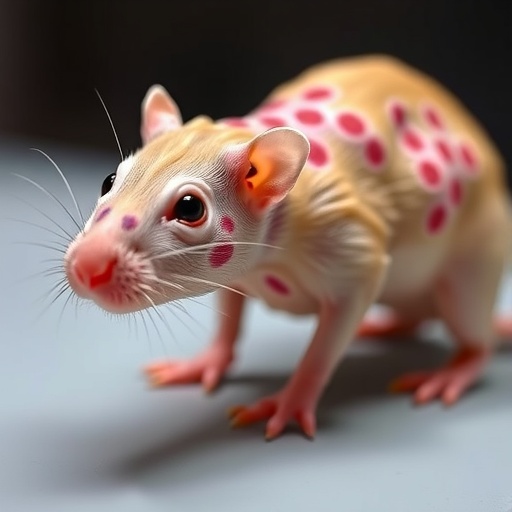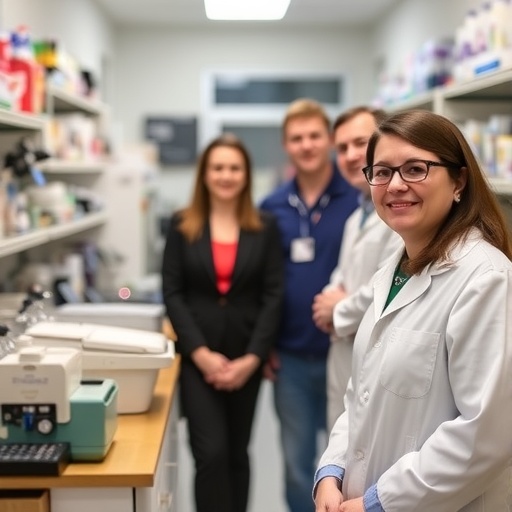In a groundbreaking advancement that challenges long-standing beliefs about cancer resistance, researchers at Moffitt Cancer Center have successfully developed the first genetically engineered model of lung cancer in naked mole rats, a species historically regarded as nearly impervious to cancer development. Published in the prestigious journal Cancer Discovery, this study unveils intricate molecular pathways that govern tumor initiation and progression in these fascinating subterranean rodents, potentially transforming our understanding of cancer biology and opening new avenues for therapeutic innovation.
For decades, naked mole rats have captivated scientists due to their extraordinary longevity and apparent immunity to cancer, prompting speculation that their cells harbor unique anti-cancer mechanisms. This remarkable resilience has positioned them as a natural model organism for uncovering the molecular underpinnings of tumor suppression. Using cutting-edge CRISPR-Cas9 gene-editing technology, the Moffitt research team introduced a specific oncogenic genetic alteration—known as the EML4-ALK fusion gene—into naked mole rat cells. This genetic fusion, well-documented as a potent driver of lung cancer in humans and murine models, initiates unchecked cellular proliferation and tumor formation in those species.
Contrary to expectations, the introduction of the EML4-ALK fusion alone did not induce lung tumors in the naked mole rats, indicating an inherent resilience to this oncogenic signal. Subsequent experiments revealed that tumorigenesis required additional genetic hits—in particular, the simultaneous loss of two critical tumor suppressor genes, p53 and Rb1. These genes are pivotal guardians of genomic integrity, executing cellular programs that prevent malignancy by initiating DNA repair, cell cycle arrest, or apoptosis in response to oncogenic stress. Only upon the combined presence of EML4-ALK and the inactivation of p53 and Rb1 did roughly 30% of the naked mole rats develop aggressive lung tumors.
Remarkably, these induced tumors paralleled a rare but clinically significant subtype of human lung cancer known as pleomorphic carcinoma. Characterized by diverse cellular morphology and aggressive behavior, pleomorphic carcinoma is often refractory to current targeted therapies. The morphological and molecular fidelity of tumors in naked mole rats thus establishes this model as an invaluable platform for probing disease mechanisms and testing novel interventions, potentially bridging gaps between preclinical studies and patient outcomes.
Dr. Joseph Kissil, senior author of the study and chair of Moffitt’s Molecular Oncology Department, highlighted the significance of the findings: “Our work demonstrates that naked mole rats, like humans, require multiple genetic alterations to overcome intrinsic tumor suppression and initiate malignancy. This insight underscores their value as a more genetically faithful model for studying early cancer events compared to traditional murine models.” By reflecting the multifactorial nature of human tumorigenesis, naked mole rats may enable scientists to dissect complex oncogenic interactions with unprecedented precision.
Another compelling aspect of this research lies in the characterization of the tumor microenvironment within naked mole rats. The researchers documented a heterogeneous infiltrate of immune cells, including T lymphocytes and macrophages, within the tumors—elements known to influence cancer progression and response to therapy. The presence of active immune components mirrors human tumor biology more accurately than many existing animal models, suggesting that naked mole rats can also serve as a unique system for immuno-oncology studies. Understanding how cancer interacts with the immune system in this species may unlock insights into immune surveillance mechanisms that contribute to their natural cancer resistance.
Despite the logistical challenges associated with breeding and maintaining naked mole rats in laboratory settings—given their specialized social structures and environmental needs—the research team advocates for the broader adoption of these animals as a robust cancer research model. Unlike mice, whose tumorigenic processes often rely on singular oncogenic drivers, naked mole rats embody the complexity and multiplicity of genetic events required for malignant transformation in humans, thereby offering a more clinically relevant investigative tool.
The development of this model was a painstaking, years-long process that involved the creation of specialized molecular tools and the optimization of gene delivery systems tuned to the naked mole rat’s unique biology. This foundational work establishes a comprehensive platform from which future studies can systematically unravel the earliest stages of lung cancer initiation, monitor tumor evolution, and evaluate the efficacy of therapeutic agents tailored to intricate oncogenic pathways.
Moreover, this platform is poised to shine light on pleomorphic lung carcinoma, a cancer subtype that remains poorly understood and lacks effective targeted treatments. By recapitulating the cellular and molecular landscape of this disease in a genetically defined animal model, researchers can conduct mechanistic analyses and high-throughput drug screening with greater translational applicability.
The implications of this study extend beyond lung cancer. Unraveling how naked mole rats resist tumorigenesis until multiple stringent genetic alterations coalesce may illuminate generalizable principles of cancer prevention inherent in biology. These insights could translate into innovative strategies for enhancing tumor suppression or circumventing resistance mechanisms in human patients.
Finally, this research underscores the critical importance of integrating comparative biology with cutting-edge genetic engineering to develop advanced disease models. The naked mole rat’s unique evolutionary adaptations present a natural experiment in cancer biology; leveraging these adaptations with precise molecular tools heralds a new era in oncology research that transcends conventional paradigms.
As the scientific community seeks effective therapies for elusive and aggressive cancers, the advent of the naked mole rat lung cancer model offers a beacon of hope. Through meticulous and rigorous study of this novel system, researchers aspire to unlock therapeutic strategies not only to combat lung cancer but also to redefine cancer prevention and treatment paradigms at large.
Subject of Research: Animals
Article Title: An Autochthonous Model of Lung Cancer Identifies Requirements for Cellular Transformation in the Naked Mole-Rat
News Publication Date: 8-Sep-2025
Web References:
Moffitt Cancer Center
Lung Cancer Information
Cancer Discovery Article
References:
Kissil, J. et al. (2025). An Autochthonous Model of Lung Cancer Identifies Requirements for Cellular Transformation in the Naked Mole-Rat. Cancer Discovery. DOI: 10.1158/2159-8290.CD-25-0526.
Keywords: Cancer research
Tags: cancer biology advancementsCRISPR-Cas9 gene editing in rodentsEML4-ALK fusion gene studygenetically engineered cancer modelslongevity and cancer resistance in animalslung cancer resistance mechanismsMoffitt Cancer Center breakthroughsmolecular biology of cancernaked mole rats cancer researchtherapeutic innovations in cancer treatmenttumor initiation pathways in mammalsunique anti-cancer mechanisms





